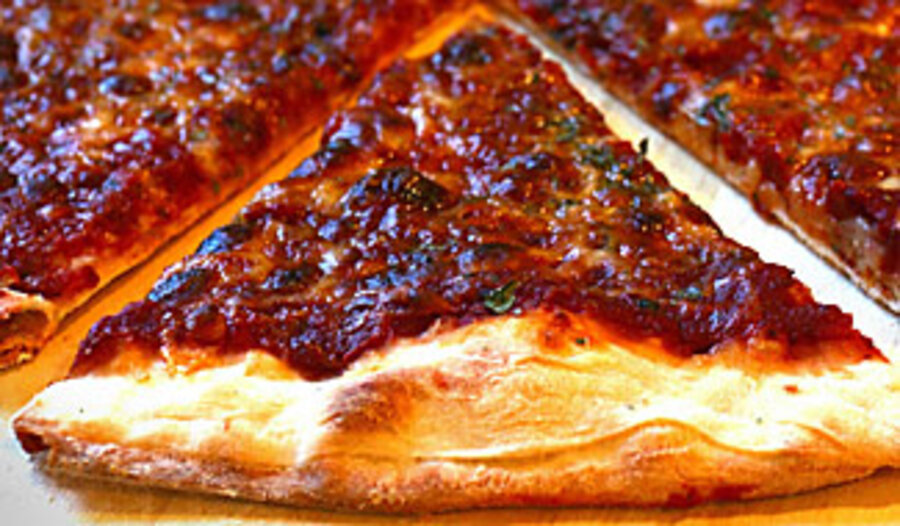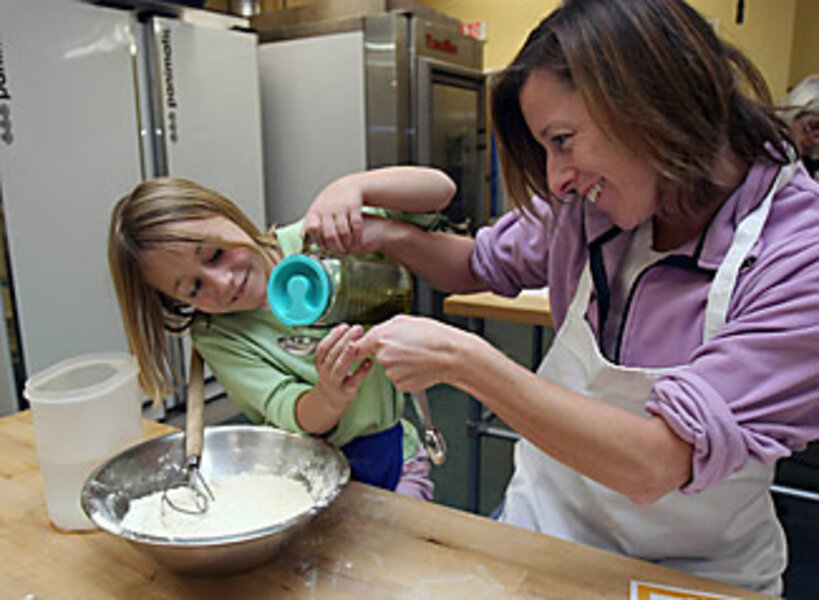Knee-high cooks grow skilled in the kitchen
Loading...
While at a bridge party one Saturday evening, the hostess thoughtfully invited two young girls to keep her own daughter out of the way and entertained in the kitchen. I tried to concentrate on my bridge hands, but I couldn't help glancing through the open kitchen door just a few steps away.
The girls were having a ball. They were preparing pizza totally from scratch: the hand-kneaded yeast dough, the fresh-cooked tomato pizza sauce, and the toppings – a variety of just-cut-up, nicely arranged items on small plates.
These girls were obviously used to having fun in the kitchen, and I was immensely impressed that they chose kitchen work over watching a video or television. It was also obvious to me that they considered cooking fun, not a chore.
Our hostess did not seem to share her daughter's passion for cooking. In the middle of fresh spring asparagus season, she shamelessly opened a can of asparagus as our vegetable side dish. Making pizza may have been unappealing to her, but her daughter knew that if she wanted pizza, she had three choices: store-bought frozen stuff that resembles pizza, one ordered from a pizza takeout, or pizza of her very own making.
The three girls divided the various tasks among them: One prepared the pizza dough, one created the sauce (from scratch), and the third sliced up pepperoni, mushrooms, and peppers, and measured out grated mozzarella. While the yeast dough was rising, the girls retired to a bedroom to play. Later, the one in charge of the dough came back in the kitchen to punch down the dough and let it rise again after a short knead.
Many bridge hands later, the three returned to the kitchen, rolled out the dough on a flour-dusted work surface, assembled the pizza on top of a pizza pan, and slipped it into a very hot oven. In a few minutes, it smelled heavenly.
Ten minutes later, the pizza was ready to eat.
I conduct cooking classes for children. They always seem to enjoy themselves thoroughly, whether I am demonstrating or let them have hands-on fun.
Even very little children, 2 years old or younger, love to feel raw foods, dough, pastry, and batter with their little fingers. In my classes, my young pupils can focus their attention for a surprisingly long time. They also like to smell and sample anything edible in the kitchen.
Of course, they prefer the hands-on part, but what they love most is to eat what they make. Often we partially prepare foods in the class, and students take them home to finish cooking or baking. Their pleasure and pride at the end of the class are a joy.
My students' most favorite task is preparing something with dough: either yeast dough, pastry dough, or pie dough. I provide them with premeasured ingredients and, after a short demonstration, I turn things over to them. I also bring a ready-to-bake batch of the same thing that bakes in the oven while the kids are at work. By the time they are finished with their task, we are ready to sample our hot, fresh-baked goodies.
But cooking should not simply be about fun: Students must learn about cleanliness in the kitchen, personal and food safety, as well as good nutrition. And there's no cooking without cleanup, especially for projects involving dough.
Many adults and many kids turn away from cooking for one single reason: poor tools. Having good tools and equipment, and instilling the idea of continuous cleanup make kitchen work satisfying. Reading and carefully following recipes is a skill, too, but so is the accurate measuring of ingredients.
When they are old enough to handle knives safely, teaching children expert and prudent knife skills (first demonstrated, then hands-on) is absolutely invaluable. I find that most children are ready to handle knives by the age of 9 or 10, with close supervision of one grown-up to three children.
No cooking class is complete without some understanding of what's going on in the cooking pot or in a mixing bowl. All of a sudden, learning a little physics and chemistry (and that's all that cooking is) becomes easy, natural, and part of the cooking process.
Working with yeast in the kitchen even adds the idea of working with live creatures – something that children find fascinating. What about arithmetic? When we halve a recipe that calls for a half teaspoon of salt, how much salt do we add? And how do we measure half of three quarters of a teaspoon of salt?
Children quickly realize that kitchen work is easy and efficient when you have skill and good tools. And discovery in the kitchen, not to mention its tasty rewards, brings out the child in all of us.
Start making the dough three hours before you want to eat your pizza. Make sure you have a 12-inch pizza pan available.
For the dough:
3/4 teaspoon dry yeast
1/2 cup very warm water
Pinch of sugar
1-1/2 cups all-purpose flour
1/2 teaspoon salt
1 tablespoon olive oil or vegetable oil
1-3/4 cups pizza sauce (recipe follows)
1 cup (4 oz.) shredded mozzarella
3 oz. sliced pepperoni or salami, or sliced vegetables
For the sauce:
5 oz. (10 tablespoons) tomato paste
2 cloves garlic, crushed
1/2 teaspoon salt
1 teaspoon sugar
Sprinkling of chili flakes
1 tablespoon fresh oregano, chopped or 1 teaspoon dry, crushed
1 cup water
To make the pizza dough: Stir the yeast into 1/2 cup of very warm water (110 to 115 degrees F.) with a pinch of sugar. It should bubble and smell like bread in about 5 minutes.
Dump the flour onto a large cutting board or work surface, sprinkle salt over flour and thoroughly mix with fingers. Add oil, mix again, then sprinkle in the water-yeast mixture to form a dough. Add a few drops more water or a dusting of flour, as needed, to make a dough that's not too sticky, not too dry, and easily workable.
Knead the dough by hand for 10 minutes. When it's soft and elastic, sprinkle with flour and let rise in a small plastic bag in a warm place (very warm room temperature) until it's doubled in size, about 1 to 1-1/2 hours. Punch down the dough with your fist and let the dough "rest" for 10 minutes to relax the gluten, then roll it out with a pastry roller or stretch it out by hand to make a thin circle that's a little larger than the pizza pan. If the dough resists stretching, let it rest longer.
To make the sauce: Combine first 6 ingredients in a saucepan. Add one cup water. Cover, bring to a boil, and then simmer gently for 15 minutes. Let cool before spreading on pizza dough.
Preheat oven to 450 degrees F. Gently place dough in the pizza pan and pinch a lip around the edge to hold in the sauce.
Cover the dough with the sauce, mozzarella cheese, and toppings. Place pizza in preheated oven until sauce and cheese are bubbly and crust is beginning to brown, 12 to 16 minutes. Serves 2 to 3.






